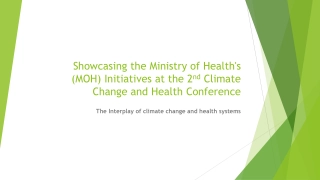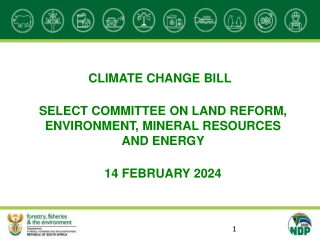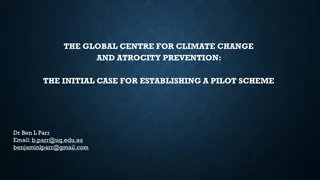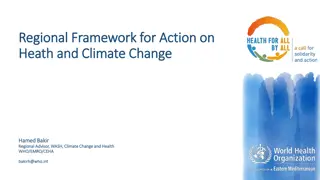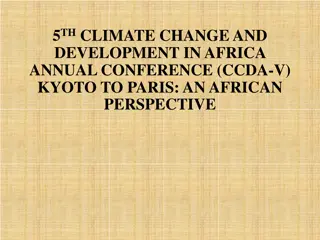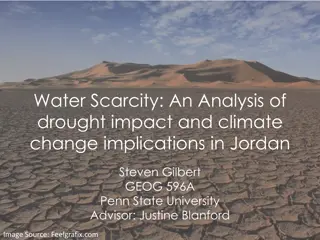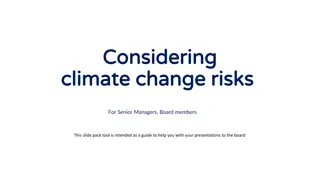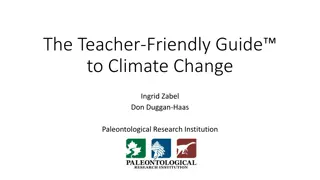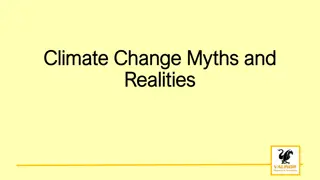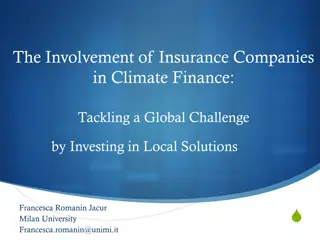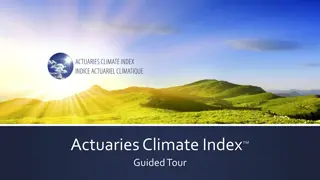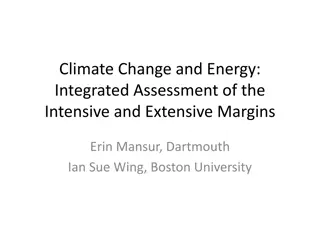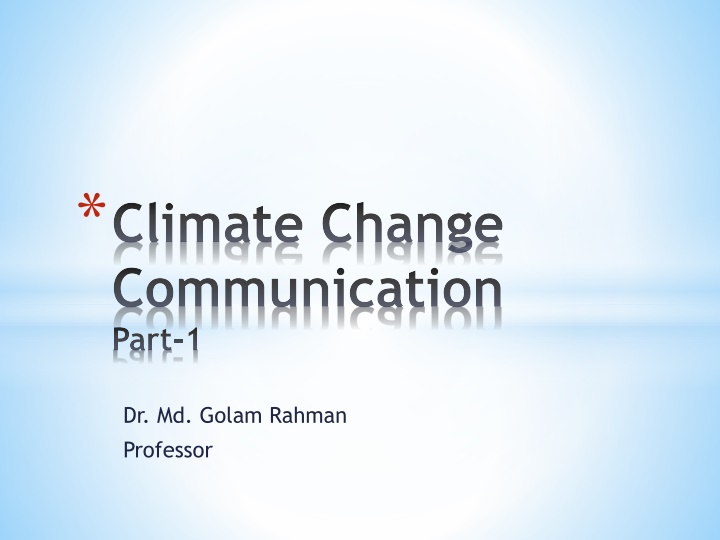
Climate Change and Communication Process
Explore the impacts of climate change, its main causes, and factors affecting climate in this informative content. Learn about the need for effective climate change communication to address this critical global issue.
Download Presentation

Please find below an Image/Link to download the presentation.
The content on the website is provided AS IS for your information and personal use only. It may not be sold, licensed, or shared on other websites without obtaining consent from the author. If you encounter any issues during the download, it is possible that the publisher has removed the file from their server.
You are allowed to download the files provided on this website for personal or commercial use, subject to the condition that they are used lawfully. All files are the property of their respective owners.
The content on the website is provided AS IS for your information and personal use only. It may not be sold, licensed, or shared on other websites without obtaining consent from the author.
E N D
Presentation Transcript
*Climate Change Communication Part-1 Dr. Md. Golam Rahman Professor
*A change in the average conditions, such as temperature and rainfall, in a region over a long period of time. *Temperatures are rising world-wide due to greenhouse gases trapping more heat in the atmosphere. Droughts are becoming longer and more extreme around the world. Tropical storms becoming more severe due to warmer ocean water temperatures. *These include warming temperatures and changes in precipitation, as well as the effects of Earth's warming, such as: Rising sea levels. [Wikipedia] *What is Climate Change?
*On the surface, climate change communication is about educating, informing, warning, persuading, mobilizing and solving this critical problem. At a deeper level, climate change communication is shaped by our different experiences, mental and cultural models, and underlying values and worldviews. * [YALE PROGRAM ON CLIMATE CHANGE COMMUNICATION, (https://climatecommunication.yale.edu/about/what-is-climate- change-communication/ (17-02-2021)] * What is Climate Change Communication?
*Carbon dioxide is the main cause of human- induced climate change. It stays in the atmosphere for a very long time. Other greenhouse gases, such as nitrous oxide, stay in the atmosphere for a long time. *Global warming is caused by the greenhouse effect, a natural process by which the atmosphere retains some of the Sun's heat, allowing the Earth to maintain the necessary conditions to host life. Without the greenhouse effect, the average temperature of the planet would be -18 C. *What is the main cause of climate?
LOWEREN is an acronym for 6 factors that affect climate * Latitude: It depends on how close or how far it is to the equator. This is the most important, and it is based on the concentration of sunlight and the area that it affects. * Ocean currents: Certain ocean currents have different temperatures. Warm ocean currents warm the air above it, which warms the coast. Cold ocean currents cool the air above it, which cools the coast. This helps keep the coast at a consistent temperature. * Wind and air masses: Heated ground causes air to rise which results in lower air pressure. As it rises it cools and descends to the ground resulting in high air pressure. This cycle repeats, creating wind. These air masses absorb the climate of the air below it. *6 major factors that affect climate..1
*Elevation: The higher up you are, the colder and drier it will be. When air rises it expands due to low air pressure which causes it to cool. *Relief: The differences in the elevation inland. As air is forced to rise over a piece of land (e.g., a mountain) the temperature decreases and condensation increases. As it condensates water droplets get bigger and heavier and are forced to fall. Once the air mass goes over the mountain the temperature and evaporation increases but condensation decreases, resulting in a halt in precipitation and rain shadows. * 6 major factors that affect climate..2
*Bangladesh is one of the largest deltas in the world which is highly vulnerable to natural disasters. The geographical location, flat and low-lying landscape, population density, poverty, illiteracy, lack of institutional setup etc are the reasons for Climate Change. *In other words, the physical, social as well as economic conditions of Bangladesh are very typical to any of the most vulnerable countries to natural disasters in the world. * Climate Change & its Impacts on Bangladesh.. [Anne-Katrien Denissen, NCDO, http://www.ncdo.nl/artikel/climate-change-its- impacts-bangladesh (17-02-2021)]
*The total land area is 147,570 sq. km. consists mostly of floodplains (almost 80%) leaving major part of the country (with the exception of the north-western highlands) prone to flooding during the rainy season. *Threats include sea level rise (approximately a fifth of the country consists of low-lying coastal zones within 1 meter of the high water mark), droughts, floods, and cyclones (approximately 130,000 people were killed in the cyclone of April 1990). *Climate Change & its Impacts on Bangladesh..2
Climatic Impacts: *The adverse affects of climate change especially high temperature, sea-level rise, cyclones and storm surges, salinity intrusion, heavy monsoon rain etc. has aggravated the overall economic development. *Bangladesh experiences different types of Natural Disasters almost every year because of the Global Warming as well as Climate Change impacts, these are: * Climate Change & its Impacts on Bangladesh..3
*Floods / Flash Floods: Almost 80% of the total area of the country is prone to flooding *Cyclones and Storm Surges: South and South- eastern Parts of the country were hit by Tropical Cyclones during the last few years *Salinity Intrusion: Almost the whole Coastal Belt along the Bay of Bengal is experiencing Salinity problem *Climate Change & its Impacts on Bangladesh..4
*Extreme Temperature and Drought (North and North-western regions of the country are suffering because of the Extreme Temperature problem). *Climate Change & its Impacts on Bangladesh..5
Sectoral Impacts: *Agriculture and Fisheries: *As already mentioned earlier, the economy of Bangladesh is based on agriculture mainly, with two thirds of the population engaged (directly or indirectly) on agricultural activities. So, the overall impact of climate change on agricultural production in Bangladesh would be wide spread and devastating for the country s economy. *Climate Change & its Impacts on Bangladesh..6
*impacts of Climate Change such as - Extreme Temperature, Drought, and Salinity Intrusion etc. are also responsible for the declining crop yields in Bangladesh. Temperature and Rainfall changes have already affected crop production in many parts of the country and the area of arable land has decreased to a great extent. *Climate Change & its Impacts on Bangladesh..7
*The Salinity intrusion in the coastal area is creating a serious implications for the coastal land that were traditionally used for rice production. *The fisheries sector has also experienced an adverse affect because of the impacts of Climate Change. The fisheries sector contributes about 3.5% of the GDP in Bangladesh and people depend on fish products in order to meet up majority of their daily protein requirements. There are around 260 species of fish in the country and almost all the varieties are sensitive to specific salt and freshwater conditions. *Climate Change & its Impacts on Bangladesh..8
Water Resources and Hydrology: *In a high density country like Bangladesh, the effects of climate change on the surface and ground water resources will be very severe and alarming. Changes to water resources and hydrology will have a significant impact on the country s economy, where people mostly depend on the surface water for Irrigation, Fishery, Industrial production, navigation and similar other activities. *Climate Change & its Impacts on Bangladesh..9
*Coastal Areas: *Almost one forth of the total population of the country live in the coastal areas of Bangladesh, where majority of the population are some how affected (directly or indirectly) by Coastal Floods / Tidal Surges, River-bank Erosion, Salinity, Tropical Cyclones etc. *With the rise of Sea-level up to one meter only, Bangladesh could lose up to 15% of its land area under the Sea water and around 30 million people living in the coastal areas of Bangladesh could become Refugees because of Climate Change impacts. (cont..) *Climate Change & its Impacts on Bangladesh..10
*Since most of the country is less than 10 meters above Sea level and almost 10% of the population of the country is living below 1 meter elevation - the whole coastal area is Highly Vulnerable to High Tides and Storm Surges. Moreover, the Bay of Bengal is located at the tip of the north Indian Ocean, where severe Cyclonic storms as well as long Tidal waves are frequently generated and hit the coast line with severe impacts because of the Shallow as well as Conical shape of the Bay near Bangladesh. *Climate Change & its Impacts on Bangladesh..11
*Forestry / Biodiversity: *Bangladesh has got a wide diversity of Ecosystems including Mangrove forests at the extreme south of the country. The Sundarbans a World Heritage, is the largest Mangrove Forest in the world, comprising 577,00 ha of land area along the Bay of Bengal. A total of 425 species have been identified there, the most significant is the famous Royal Bengal Tiger. Therefore, Climate Change impacts will have negative effects on the Ecosystem of the Forest recourses in Bangladesh while the Sundarbans is likely to suffer the most. *Climate Change & its Impacts on Bangladesh..12
Urban areas: *Cities and Towns situated along the Coastal belt in Bangladesh are at the Front line of Climate Change related Disaster impacts and could experience a severe damage directly because of the Sea level Rise and Storm Surges at any time. Direct impacts may occur through the increased Floods, Drainage congestion and Water logging as well as Infrastructure Damage during extreme events. (cont..) *Climate Change & its Impacts on Bangladesh..13
*The important Urban sectors that suffered severely by the previous floods in Bangladesh include Urban Infrastructure, Industry, Trade, Commerce and Utility services etc. *As consequence, it hampered usual productivity during and after major floods and hence increased the vulnerability of the urban poor by many folds. *Around 40 per cent of the urban population in Bangladesh lives in the Slum and Squatter settlements of the major cities which are highly prone to Disaster risk during Flooding further. *Climate Change & its Impacts on Bangladesh..14
Vulnerable groups: * The Urban poor are therefore directly at the risk of Natural Disasters being enhanced by the impacts of Climate Change - especially in the absence / shortage of the necessary Infrastructure as well as Employment opportunity for them in the major cities of the country. In Bangladesh, Women are especially Vulnerable because of the Gender inequalities in the Socio- economic and Political institutions. * During the 1991Cyclone and Storm surge in Bangladesh, the death rate in case of women was almost five times higher than the men. Because men were able to communicate with each other in the public spaces, but the information did not reach most of the women timely. *Climate Change & its Impacts on Bangladesh..15
*Riverbank erosion is the primary cause of climate displacement inland. Up to 50% of those now living in Bangladesh s urban slums may be there because they were forced to flee their rural homes as a result of riverbank erosion. *River flooding is also a cause of displacement inland, and along with erosion is likely to become more significant under climate change, as rainfall both increases and becomes more erratic, and the melting Himalayan glaciers alter river flows. *.
*Questions Comments

